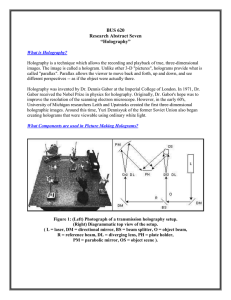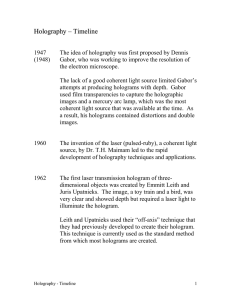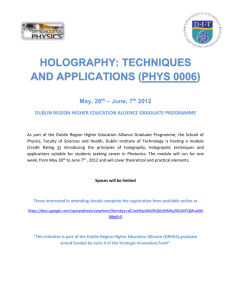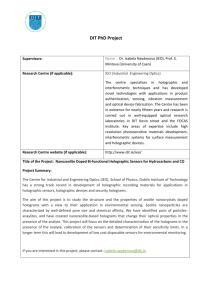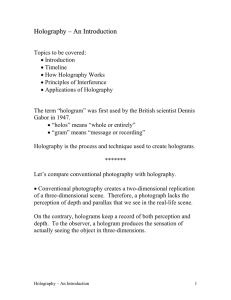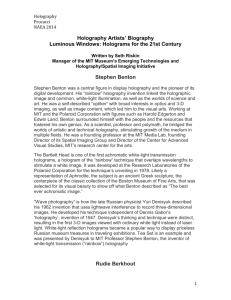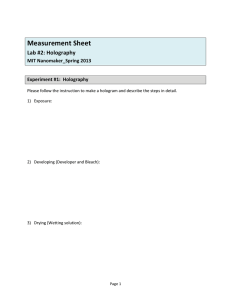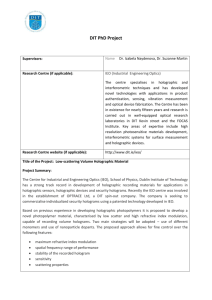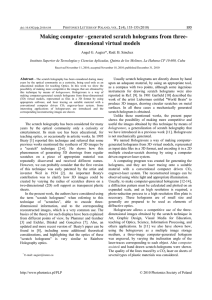MAS.450/854 – HOLOGRAPHIC IMAGING Spring 2002 Course Outline l. Introduction:
advertisement
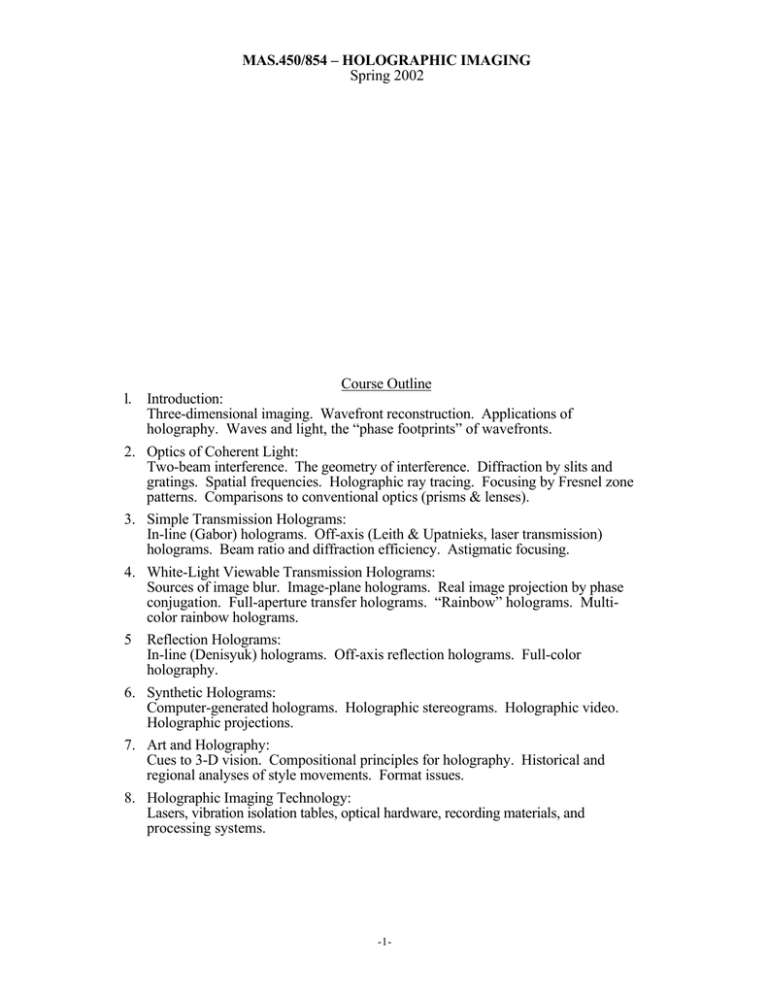
MAS.450/854 – HOLOGRAPHIC IMAGING Spring 2002 Course Outline l. Introduction: Three-dimensional imaging. Wavefront reconstruction. Applications of holography. Waves and light, the “phase footprints” of wavefronts. 2. Optics of Coherent Light: Two-beam interference. The geometry of interference. Diffraction by slits and gratings. Spatial frequencies. Holographic ray tracing. Focusing by Fresnel zone patterns. Comparisons to conventional optics (prisms & lenses). 3. Simple Transmission Holograms: In-line (Gabor) holograms. Off-axis (Leith & Upatnieks, laser transmission) holograms. Beam ratio and diffraction efficiency. Astigmatic focusing. 4. White-Light Viewable Transmission Holograms: Sources of image blur. Image-plane holograms. Real image projection by phase conjugation. Full-aperture transfer holograms. “Rainbow” holograms. Multicolor rainbow holograms. 5 Reflection Holograms: In-line (Denisyuk) holograms. Off-axis reflection holograms. Full-color holography. 6. Synthetic Holograms: Computer-generated holograms. Holographic stereograms. Holographic video. Holographic projections. 7. Art and Holography: Cues to 3-D vision. Compositional principles for holography. Historical and regional analyses of style movements. Format issues. 8. Holographic Imaging Technology: Lasers, vibration isolation tables, optical hardware, recording materials, and processing systems. -1- Conduct of the Course Although the reading list covers a wide variety of books on holography, none of them is a particularly good match to the imaging and research-preparatory orientation of this course. We will circulate drafts of Prof. Benton’s forthcoming book on holography, and occasionally refer to a book by P.M. Hariharan entitled Optical Holography, now available in paperback. For getting started in holographic practice, the Holography Handbook, by Unterseher, Hansen and Schlesinger is an easy-to-follow account of holography at an advanced craft level. Less funky and more advanced is Saxby’s new edition of Practical Holography, which we are evaluating as a reference source (your comments will be welcomed). Details of all of these are in the Reading List. This course will attempt to navigate between these extremes, conveying a working knowledge of the underlying physical principles and their mathematical descriptions, and a working knowledge of state-of-the-art laboratory techniques. There will be laboratory exercises almost every week that will roughly track the lecture topics. Lab notes will be distributed ahead of time and must be studied before coming to the lab. You will need a lab notebook of the usual spring-bound variety, in which you are expected to document your experiments and their results. Learning to maintain an effective notebook is an important part of these labs. Your sketches and notes should be complete and clear enough to permit someone else to reproduce your results. The results (observations and data) should be clearly noted in their raw form, and refined and analyzed separately. Your lab book will be evaluated twice during the term. There is a lab fee of $50 for the course, to cover the holographic recording materials and processing chemistry used. There will be several problem sets (one almost every week) and two quizzes during the term, which will have different components for MAS.450 (undergraduates) and MAS.854 (graduate) students. There will not be a final examination. However, a final project is required, which will replace the labs for the last two weeks of the course, and which will be presented during the final exam period both orally and as a written report (you must plan to be present during the final exam period). The overall grade is made up of roughly one-quarter lab & notebook, one-quarter homework, one-quarter quizzes, and one-quarter final project. We hope that a wide variety of students with a wide variety of backgrounds and motivations will find this course interesting. But there will be a definite theoretical and mathematical emphasis to the conduct of the course, as we work to lay the foundations for a new research program in holography at MIT. We occasionally have to employ concepts from calculus (and complex algebra & phasors for graduate students), but the everyday working level will be based on what we call “shop math,” by which we mean the algebra, plane geometry and trigonometry that people like toolmakers use in pursuit of their trade. You will need a calculator that handles trig functions (and pencils of several colors) for the homework and for the quizzes. For many of you, shop math will make some discussions much longer and more tedious than they need to be; use the extra time to contemplate the optical mysteries involved! The Institute Laboratory Requirement: This subject satisfies the Institute’s requirement that every student take at least one handson laboratory course while they are at MIT. You will find that the laboratory component of this course is very much “hands-on,” but the Institute requires even more. You are also expected to gain some knowledge of the “scientific method,” and of good scientific procedures (including observation and documentation), and to participate in the design and completion of a project of your own that involves some technical challenges (and includes progress reports and a summary report). Our approach is to go over some of this material in class, and again in the lab sessions, and to expect you to maintain a good lab notebook (which will be graded twice for good observation and data analysis). Further, you will choose a final project to undertake with a small group of partners, develop the ideas involved, do the experimental work over a two week period at the end of the term, and present oral and written reports of the results. The labs are intended to be interesting and enjoyable by themselves (if a little long!), but the parallel written work is an important part of satisfying the formal Institute Laboratory requirements, and will also be a significant factor in your final grade. -2-
